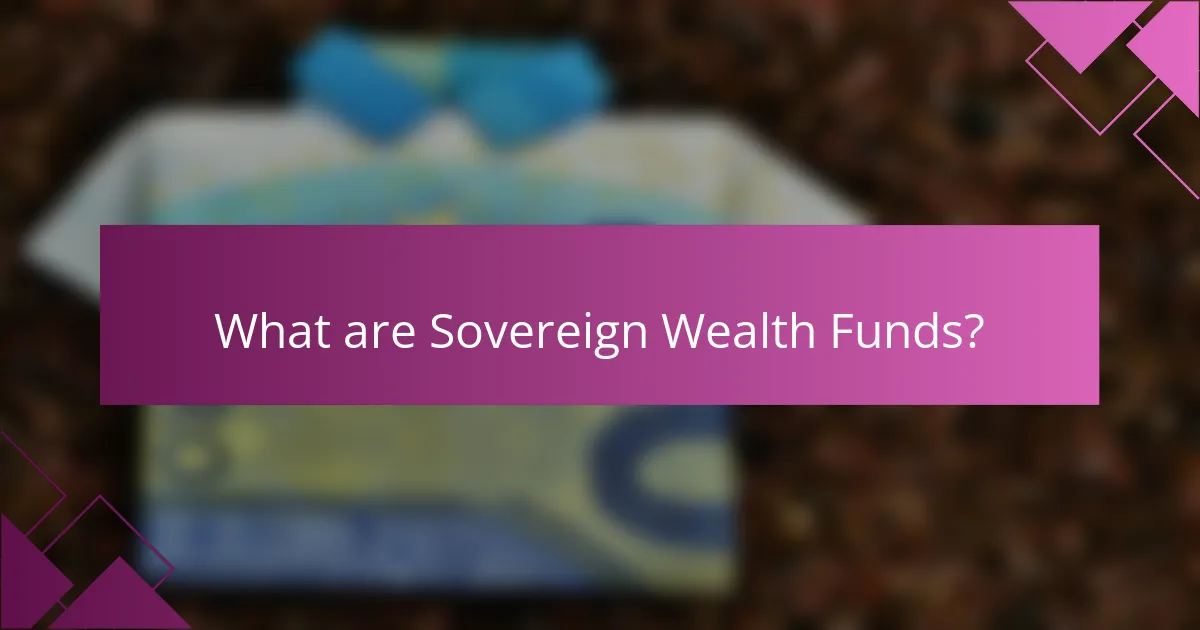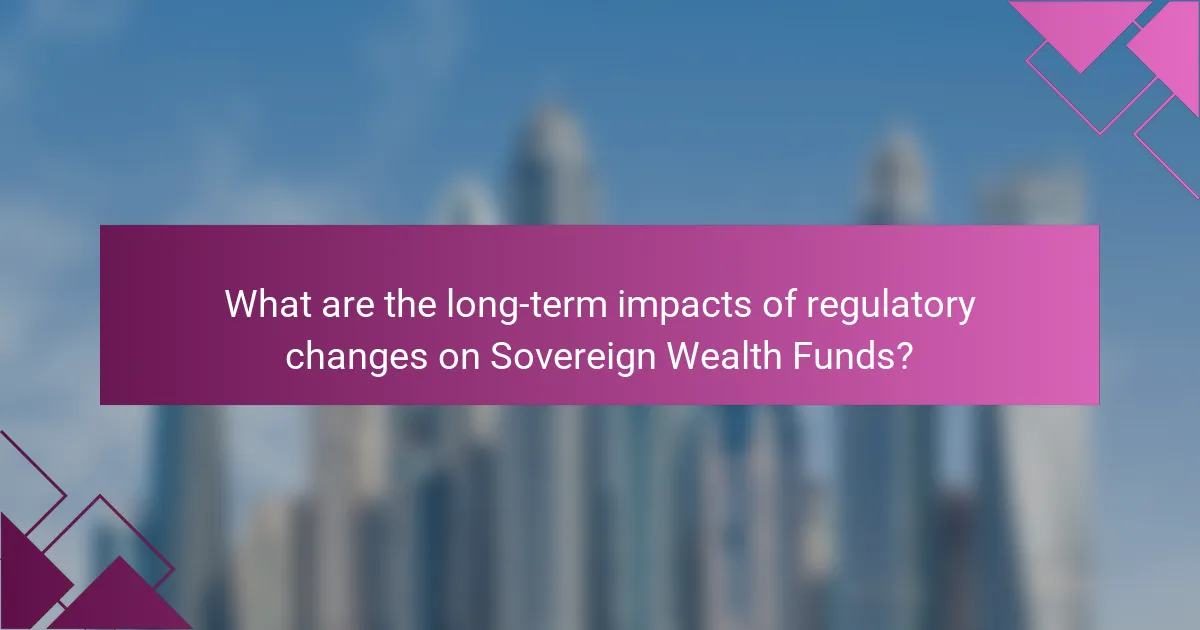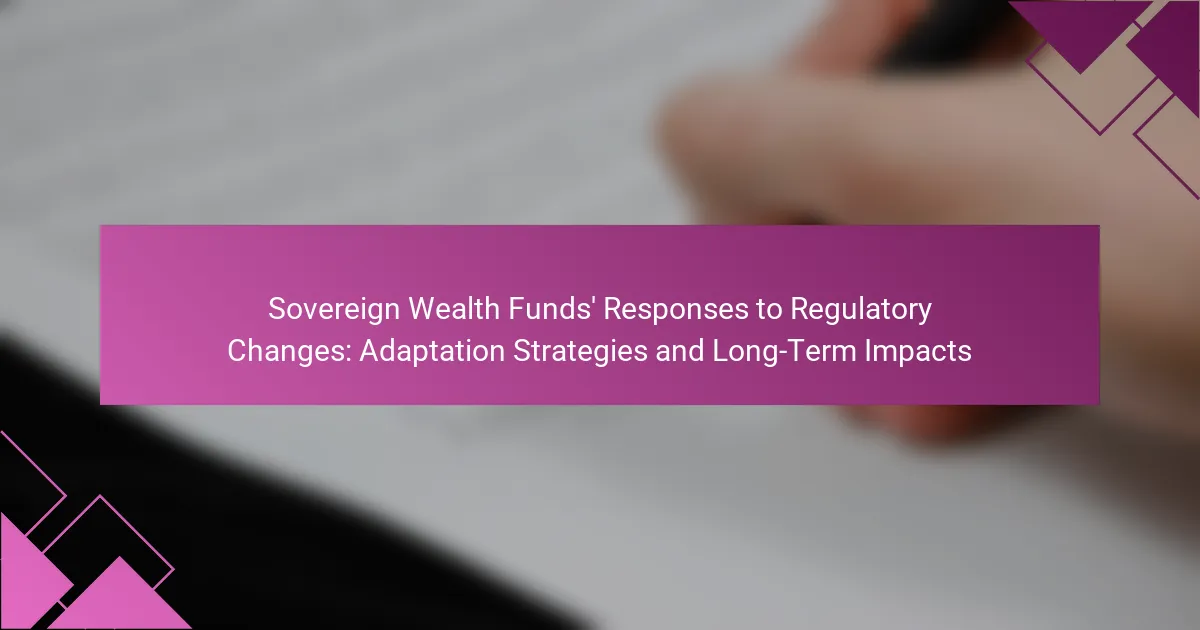
What are Sovereign Wealth Funds?
Sovereign Wealth Funds (SWFs) are state-owned investment funds or entities. They manage a country’s reserves for investment purposes. SWFs invest in various asset classes, including stocks, bonds, real estate, and infrastructure. The primary goal of these funds is to generate returns for the benefit of the country’s economy and its citizens. According to the Sovereign Wealth Fund Institute, there are over 90 SWFs globally, managing more than $9 trillion in assets. These funds often play a significant role in global financial markets. They can also influence economic stability and development in their home countries.
How do Sovereign Wealth Funds operate?
Sovereign Wealth Funds (SWFs) operate by managing national savings for investment purposes. They are typically funded by surplus revenues from natural resources, foreign exchange reserves, or fiscal surpluses. SWFs invest in a variety of asset classes, including stocks, bonds, real estate, and infrastructure projects. Their primary goal is to generate long-term financial returns while diversifying the country’s income sources.
SWFs are usually governed by specific investment strategies and guidelines set by their respective governments. They often aim to stabilize the economy during downturns by providing liquidity. According to the International Working Group of Sovereign Wealth Funds, there are over 90 SWFs globally, managing assets exceeding $10 trillion. This demonstrates their significant role in the global financial landscape.
What are the key characteristics of Sovereign Wealth Funds?
Sovereign Wealth Funds (SWFs) are state-owned investment funds. They manage national savings for investment purposes. SWFs typically invest in a diverse range of assets. These include stocks, bonds, real estate, and infrastructure. They aim to achieve long-term financial returns. SWFs are often funded by revenues from natural resources or fiscal surpluses. They play a significant role in global financial markets. According to the Sovereign Wealth Fund Institute, there are over 90 SWFs worldwide, managing over $9 trillion in assets.
How do Sovereign Wealth Funds differ from other investment vehicles?
Sovereign Wealth Funds (SWFs) differ from other investment vehicles primarily because they are state-owned investment funds. SWFs are established by national governments to manage and invest national savings for the purpose of economic stability and growth. Unlike private investment funds, SWFs often have a long-term investment horizon, focusing on sustainable returns rather than short-term gains. They typically invest in a diverse range of assets, including stocks, bonds, real estate, and commodities. Additionally, SWFs are funded by government revenues, such as those from natural resources or fiscal surpluses. This funding source allows them to operate with lower liquidity constraints compared to private funds. Furthermore, SWFs often aim to achieve broader economic objectives, such as stabilizing the economy during downturns, which is not the primary focus of other investment vehicles.
Why do countries establish Sovereign Wealth Funds?
Countries establish Sovereign Wealth Funds (SWFs) to manage national savings and stabilize their economies. SWFs provide a means for governments to invest surplus revenues, particularly from natural resources. They help diversify national income sources and reduce reliance on volatile commodity prices. SWFs also serve as a buffer during economic downturns, ensuring financial stability. Countries with SWFs can invest in global markets, enhancing returns on national assets. For example, Norway’s Government Pension Fund Global invests oil revenues to benefit future generations. This strategic approach promotes long-term economic growth and sustainability.
What economic goals do Sovereign Wealth Funds aim to achieve?
Sovereign Wealth Funds aim to achieve several economic goals. These include wealth stabilization, intergenerational savings, and economic diversification. Wealth stabilization helps countries manage revenues from volatile resources, such as oil. Intergenerational savings ensure that future generations benefit from current resource wealth. Economic diversification reduces dependence on a single sector, promoting stability. Additionally, Sovereign Wealth Funds often seek to achieve higher returns on investments. They invest in various asset classes, including equities, bonds, and real estate. This strategy aims to maximize returns while managing risks.
How do Sovereign Wealth Funds contribute to national stability?
Sovereign Wealth Funds (SWFs) contribute to national stability by providing financial resources that can buffer economic fluctuations. They invest surplus revenues, often from natural resources, into diverse assets globally. This diversification helps mitigate risks associated with economic downturns. SWFs can stabilize national budgets during crises by providing liquidity. For instance, during the 2008 financial crisis, several SWFs invested in distressed assets, supporting financial markets. Additionally, SWFs promote long-term economic growth through strategic investments in infrastructure and innovation. Their role in stabilizing currencies and supporting fiscal policies further enhances national stability.
What challenges do Sovereign Wealth Funds face?
Sovereign Wealth Funds face several challenges, including regulatory changes, market volatility, and geopolitical risks. Regulatory changes can affect investment strategies and asset allocation. Market volatility impacts the performance of investments, leading to potential losses. Geopolitical risks can disrupt operations and create uncertainty in investment environments. Additionally, transparency and accountability pressures are increasing. These funds must navigate complex global financial landscapes. Adapting to these challenges is essential for long-term sustainability and performance.
How do regulatory changes impact Sovereign Wealth Funds?
Regulatory changes impact Sovereign Wealth Funds (SWFs) by altering their investment strategies and risk management practices. New regulations can impose restrictions on asset classes SWFs can invest in. They may also require greater transparency and reporting, affecting operational costs. Changes in tax laws can influence the net returns on investments. For instance, the introduction of stricter compliance measures may lead to increased administrative burdens. Additionally, regulatory changes can affect the geopolitical landscape, altering investment opportunities. Historical data shows that SWFs adjusted their portfolios significantly following the 2008 financial crisis due to new regulations. These adjustments highlight the adaptability of SWFs in response to regulatory shifts.
What are the risks associated with Sovereign Wealth Funds?
Sovereign Wealth Funds (SWFs) face several risks, including market volatility, political risk, and liquidity risk. Market volatility can affect the value of investments held by SWFs. Political risk arises from changes in government policies that may impact investment strategies. Liquidity risk refers to the potential difficulty in selling assets quickly without significant loss of value. Additionally, SWFs may encounter regulatory risks due to evolving laws and regulations in different countries. Operational risks can also occur, stemming from management failures or fraud. These risks can affect the overall performance and stability of SWFs.

How do Sovereign Wealth Funds respond to regulatory changes?
Sovereign Wealth Funds (SWFs) respond to regulatory changes by adjusting their investment strategies and governance structures. They often reassess their asset allocation to comply with new laws. SWFs may increase transparency and reporting to align with regulatory expectations. They also engage in dialogue with policymakers to influence future regulations. For instance, the International Forum of Sovereign Wealth Funds promotes best practices in response to regulatory shifts. Historical examples show SWFs adapting to changes in tax laws and investment restrictions. This adaptability helps maintain their investment performance and reputation.
What adaptation strategies do Sovereign Wealth Funds employ?
Sovereign Wealth Funds (SWFs) employ various adaptation strategies to navigate regulatory changes. These strategies include diversifying investment portfolios to mitigate risks. SWFs often increase allocations to alternative assets, such as private equity and infrastructure. They also enhance compliance frameworks to align with evolving regulations. Additionally, SWFs engage in active dialogue with policymakers to influence regulatory outcomes. This proactive engagement can lead to more favorable investment conditions. Furthermore, SWFs may adjust their asset allocation based on market trends and regulatory environments. By adopting these strategies, SWFs aim to sustain long-term growth and stability.
How do Sovereign Wealth Funds adjust their investment strategies?
Sovereign Wealth Funds adjust their investment strategies by analyzing market conditions and regulatory changes. They often shift asset allocations to align with economic forecasts. This may involve increasing exposure to equities during growth phases. Conversely, they may reduce risk by moving to fixed-income securities in downturns. Additionally, they consider geopolitical factors that might impact investments. For instance, changes in trade policies can prompt reallocation. They also incorporate sustainability criteria into their strategies, responding to global trends. Recent data shows that over 70% of Sovereign Wealth Funds now prioritize ESG factors. These adjustments aim to optimize returns while managing risk effectively.
What role does governance play in adapting to regulatory changes?
Governance plays a crucial role in adapting to regulatory changes by establishing frameworks for compliance and oversight. Effective governance structures enable organizations to assess regulatory impacts systematically. They facilitate timely decision-making and resource allocation in response to new regulations. Governance also promotes transparency, ensuring stakeholders are informed about compliance strategies. Research shows that strong governance can enhance organizational resilience during regulatory transitions. For instance, a study by the International Monetary Fund highlights that well-governed entities adapt more swiftly to regulatory shifts, minimizing disruptions. Thus, governance is vital for strategic alignment with evolving regulatory landscapes.
Why is transparency important for Sovereign Wealth Funds?
Transparency is crucial for Sovereign Wealth Funds (SWFs) because it builds trust with stakeholders. Trust enhances the credibility of SWFs in managing public assets. Increased transparency can attract foreign investments. It also ensures accountability for the funds’ investment decisions. According to the International Working Group of Sovereign Wealth Funds, transparency fosters good governance. Good governance is essential for sustainable economic growth. Furthermore, transparent practices can help mitigate risks associated with mismanagement. Overall, transparency is vital for the long-term success and stability of SWFs.
How do Sovereign Wealth Funds enhance transparency in response to regulations?
Sovereign Wealth Funds enhance transparency in response to regulations by adopting standardized reporting practices. They implement frameworks such as the Santiago Principles, which promote accountability and transparency. These principles encourage funds to disclose information on governance, investment strategies, and performance metrics. Additionally, many Sovereign Wealth Funds publish annual reports that detail their financial activities and investment holdings. This practice fosters trust among stakeholders and complies with international regulatory standards. Furthermore, enhanced transparency mitigates risks associated with mismanagement and corruption. By aligning with best practices, Sovereign Wealth Funds demonstrate their commitment to responsible investment and governance.
What are the implications of transparency for investor confidence?
Transparency significantly enhances investor confidence. When investors perceive clear and open communication, they feel more secure in their decisions. Transparency reduces uncertainty about investment risks. It fosters trust between investors and fund managers. Studies show that funds with high transparency rates attract more capital. For instance, a 2018 report by the CFA Institute indicated that 70% of investors prioritize transparency in their investment choices. Increased transparency can lead to improved fund performance over time. Overall, transparency is crucial for building and maintaining investor confidence in sovereign wealth funds.

What are the long-term impacts of regulatory changes on Sovereign Wealth Funds?
Regulatory changes significantly impact Sovereign Wealth Funds (SWFs) over the long term. These changes can alter investment strategies, risk assessments, and asset allocations. SWFs may face increased compliance costs due to stricter regulations. This can lead to a reduction in overall returns. Additionally, regulatory shifts can influence the geographical focus of investments. For instance, regulations may encourage SWFs to invest more in domestic markets. Historical examples show that after the 2008 financial crisis, many SWFs adjusted their portfolios to align with new regulations. This adaptation often resulted in a shift towards more sustainable and responsible investment practices. Therefore, the long-term impacts of regulatory changes on SWFs include altered investment dynamics, compliance challenges, and a potential shift towards sustainability.
How do regulatory changes influence the performance of Sovereign Wealth Funds?
Regulatory changes significantly influence the performance of Sovereign Wealth Funds (SWFs). These changes can alter investment strategies, risk assessments, and operational frameworks. For instance, new regulations may restrict the types of assets that SWFs can invest in. This can limit diversification opportunities and affect overall returns. Additionally, compliance costs may increase, impacting net performance. Changes in tax laws can also affect after-tax returns on investments. Furthermore, regulatory changes may enhance transparency requirements, leading to increased scrutiny and potential reputational risks. Historical examples show that SWFs often adapt by reallocating assets in response to regulatory shifts. This adaptability is crucial for maintaining performance in a changing regulatory landscape.
What trends can be observed in Sovereign Wealth Fund returns post-regulation?
Sovereign Wealth Fund returns post-regulation show a trend of increased transparency and improved performance. Following regulatory changes, funds have adjusted their investment strategies. This adaptation has led to a more diversified portfolio approach. Many funds have shifted focus towards sustainable and responsible investments. The average annual return has improved, with some funds reporting gains of 5-10% post-regulation. Enhanced governance structures have also contributed to better decision-making processes. These trends indicate a positive correlation between regulation and fund performance.
How do regulatory changes affect the global standing of Sovereign Wealth Funds?
Regulatory changes significantly influence the global standing of Sovereign Wealth Funds (SWFs). These changes can alter investment strategies and asset allocations. For example, stricter regulations may limit the sectors SWFs can invest in. This can lead to reduced diversification and lower returns. Conversely, deregulation can provide SWFs with more opportunities for growth. Increased transparency requirements can enhance credibility and attract more investments. Historical data shows that SWFs in countries with favorable regulations often outperform those in heavily regulated environments. Thus, the regulatory landscape directly impacts the effectiveness and reputation of SWFs on the global stage.
What best practices can Sovereign Wealth Funds adopt for future regulatory changes?
Sovereign Wealth Funds can adopt several best practices for future regulatory changes. First, they should enhance their compliance frameworks. This includes regularly updating policies to align with new regulations. Second, they must prioritize transparency in their operations. Transparency builds trust with stakeholders and regulators. Third, engaging with regulators proactively is essential. This can help anticipate changes and influence policy development. Fourth, investing in risk management systems is crucial. Effective risk management can mitigate the impact of sudden regulatory shifts. Fifth, continuous education and training for staff should be implemented. Knowledgeable staff can better navigate complex regulatory environments. Lastly, leveraging technology for data analytics can improve decision-making. Data-driven insights can help adapt strategies to changing regulations effectively. These practices are supported by the increasing complexity of global financial regulations, which require a proactive and informed approach.
How can Sovereign Wealth Funds build resilience against regulatory shifts?
Sovereign Wealth Funds can build resilience against regulatory shifts by diversifying their investment portfolios. This diversification reduces reliance on any single market or regulatory environment. They should also engage in proactive dialogue with regulators to understand potential changes. By anticipating regulatory trends, funds can adjust their strategies accordingly. Implementing robust risk management frameworks is essential to mitigate compliance risks. Regularly reviewing and updating governance structures enhances adaptability. Additionally, investing in technology can improve compliance monitoring and reporting processes. These strategies collectively strengthen a fund’s capacity to navigate regulatory changes effectively.
What strategies can enhance the adaptability of Sovereign Wealth Funds?
Diversification of investment portfolios enhances the adaptability of Sovereign Wealth Funds. By spreading investments across various asset classes, regions, and sectors, funds can mitigate risks associated with market volatility. This strategy allows for better performance during economic downturns. Additionally, adopting flexible investment strategies enables funds to respond quickly to regulatory changes. Incorporating advanced data analytics can improve decision-making and identify emerging trends. Furthermore, collaboration with global financial institutions can provide insights into best practices. Regularly reviewing and adjusting investment policies ensures alignment with changing market conditions. These strategies collectively foster resilience and adaptability in an evolving financial landscape.
Sovereign Wealth Funds (SWFs) are state-owned investment entities that manage national savings for economic stability and growth. This article explores how SWFs operate, their key characteristics, and the economic goals they aim to achieve, including wealth stabilization and diversification. It also examines the challenges SWFs face, particularly in response to regulatory changes, and highlights their adaptation strategies to maintain performance and transparency. Additionally, the long-term impacts of regulatory shifts on SWF performance and global standing are analyzed, offering insights into best practices for resilience and adaptability in a complex financial landscape.
